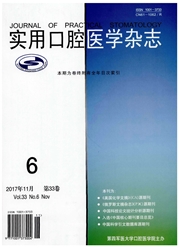

 中文摘要:
中文摘要:
目的:研究大鼠腮腺主导管结扎诱导腺体萎缩过程中腺泡细胞的变化规律。方法:通过对大鼠腮腺主导管结扎,建立腮腺组织萎缩模型,分别于结扎术后0、1、3、5、7、10、14、21和30 d 获取腮腺组织标本,苏木精-伊红(HE)和阿新蓝-过碘酸雪夫(AB-PAS)染色观察腺体的组织学变化,免疫组织化学法检测半胱氨酸天冬氨酸蛋白水解酶3(caspase3)、增殖细胞核抗原(Ki-67)、钙调节蛋白(calponin)和淀粉酶(amylase)的表达变化。结果:组织学观察见导管结扎组大鼠腮腺大部分腺泡细胞萎缩、消失,酶原颗粒消失,仅在腺小叶的边缘残存少量腺泡细胞。Caspase3在结扎7 d 组达峰值;Ki-67在结扎3 d组达峰值;各实验组间 caspase3及 Ki-67表达水平差异均有统计学意义(P <0.05)。结论:大鼠腮腺主导管结扎至30 d 时,大部分腺泡细胞萎缩、凋亡,分泌功能丧失,但在腺小叶的边缘仍存在少量腺泡细胞。
 英文摘要:
英文摘要:
Objective:To investigate the changes of acinar cells during atrophy of rat duct-ligated parotid gland.Methods:The ex-cretory duct of parotid gland was doubly ligated with metal-clip unilaterally near the hilum,and the animals were sacrificed at 0,1 , 3,5,7,1 0,1 4,21 or 30 days after ligation respectively.The evolving glands were examined with HE and AB-PAS staining tech-nique and immunohistochemistry for the observation of caspase3,Ki-67,calponin and amylase expression.Results:30-days after ligation,the majority of acinar cells were disappeared;only residual acinar cells at the peripheral region of lobules were identified by HE and AB-PAS staining accompanying decreasing zymogen granules.During the atrophy of parotid glands,the caspase3-positive cells identified by immunohistochemistry were rarely observed at 0 d,but the cell number increased in the following days.There were occasional Ki-67 positive cells in the 0 d group,but after 3-days of the ligation Ki-67 positive cells reached a peak.The difference of the caspase3-positive cell number and the Ki-67 positive cells were statistically significant among the groups(P 〈0.05).Conclu-sion:During atrophy of the parotid gland,most acinar cells apoptosed but there are still some residual acinar cells at the perip-heral region of lobules 30 days after duct-ligation.
 同期刊论文项目
同期刊论文项目
 同项目期刊论文
同项目期刊论文
 期刊信息
期刊信息
